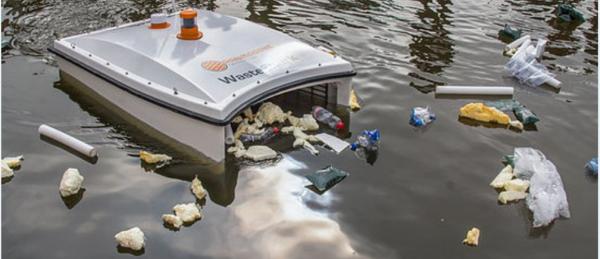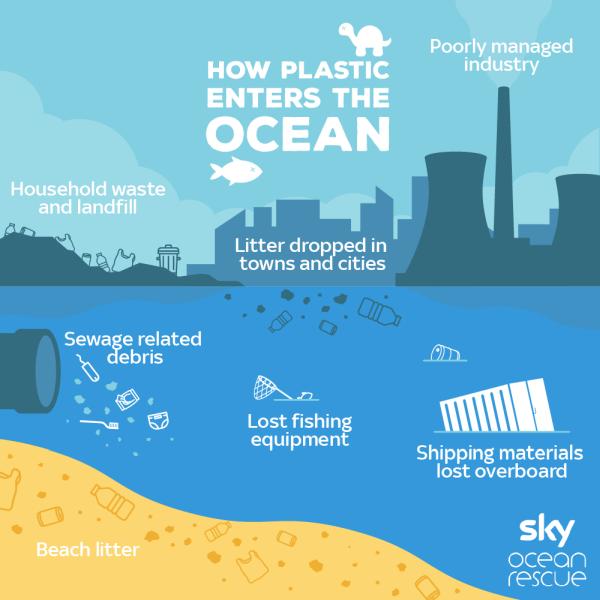While even the mention of a shark swimming close to shore is enough to send residents scurrying for cover, the “WasteShark” is being welcomed with open arms. The brainchild of South African entrepreneur Richard Hardiman, the aquatic drone is designed to devour all floating debris, including plastic and other non-biodegradable trash, that has accumulatedalong coastal waters, before it drifts out to sea.

Hardiman came up with the idea about four years ago, after observing two men using a fishing net to pick up plastic waste gathered along the Cape Town, South Africa waterfront. “Their only defense to combat this trash going out was the guy in the front with a pool net,” Hardiman said in his January 2018 TED talk. “That was it. His only defense against nature and man’s inability to tidy up after themselves…. I arrogantly thought to myself immediately, ‘I could do that better.”‘
However, given that Hardiman is neither an engineer nor a programmer, it was not an easy undertaking. The inventor says, “ Eventually, I built a prototype in my garage; it was made of plumbers piping Arduino boards, and some bilge pumps to act as motors – I put it all together with some crudely written code and tested the prototype in my pool; despite my skills, it worked!” Encouraged by the success, Hardiman partnered with Netherlands-based startups Genuin Engineering, RDM Makerspace, and Jules Dock to realize his vision.

Launched in 2016, the WasteShark draws inspiration from the whale shark, a filter feeder which can suck in large amounts of unsuspecting small fish and plankton, without much movement. The vessel’s “mouth,” located between its two parallel hulls, scoops up plastic bottles and other waste from up to a foot below the water’s surface. It can work for up to eight hours on a single charge and collect as much as 1,120 pounds (508 kilograms) of waste before returning to the collection point. The aquatic drone can be steered with the help of a remote control or by using a plotted map on an iPad. Fitted with a laser imaging system that allows it to steer clear of obstacles and “learn” the most efficient collection routes. According to Hardiman, the vessel is most effective at “waste chokeholds like harbors, rivers, and canals.” WasteShark is also equipped with sensors, which enable it to collect data, such as pH levels, salinity, and temperature, so officials can determine the area’s water quality. The portable device emits no carbon, produces no noise or light pollution, and causes no harm to marine life.
“WasteShark is cheaper, greener, more effective and less disruptive than other methods of dealing with marine litter,” said Oliver Cunningham, chief commercial officer at RanMarine, the Dutch Environmental technology company set up by Hardiman to manufacture the drone.

Thus far, WasteSharks have successfully helped clean up the harbor waters in five countries, including the Netherlands, South Africa, and the United Arab Emirates (UAE). On March 4, 2019, the United Kingdom’s Sky Ocean Rescue, in partnership with the World Wildlife Fund (WWF), joined the group with the release of a WasteShark in the Ilfracombe Harbour. Located on England’s North Devon coast, the port lies within the Marine Protected Area (MPA) that is home to a diverse species of marine animals, such as gray seals and pink sea fan corals. Collecting the plastic before it gets taken out to sea by the tide will help protect the preciouswildlife, which often mistake the colorful polymer pieces for food.
RanMarine is not the only company trying to solve this global environmental issue. Fenbits, a Sharjah, UAE-based startup, recently announced the launch of BluePhin. According to the company, the autonomous vessel can operate for up to 16 hours on a single charge and collect as much as 770 pounds (350 kilograms) of waste within two hours.
Hopefully, these drones will help stop, or at least reduce, the estimated 8.1 million tons of plastic — the equivalent of a garbage truckload entering the water every minute — that enters our oceans annually. A 2016 Ellen MacArthur Foundation study predicts that if we keep polluting at the current rate, there will be more plastic than marine animals in our oceans by the year 2050. While many countries are starting to take action by banning single-use products like plastic bags, more needs to be done to protect our innocent ocean dwellers, who are dying grisly deaths from eating and getting caught in plastic.
Source: Trash-Eating “Sharks” Are Taking Over Harbors Worldwide
